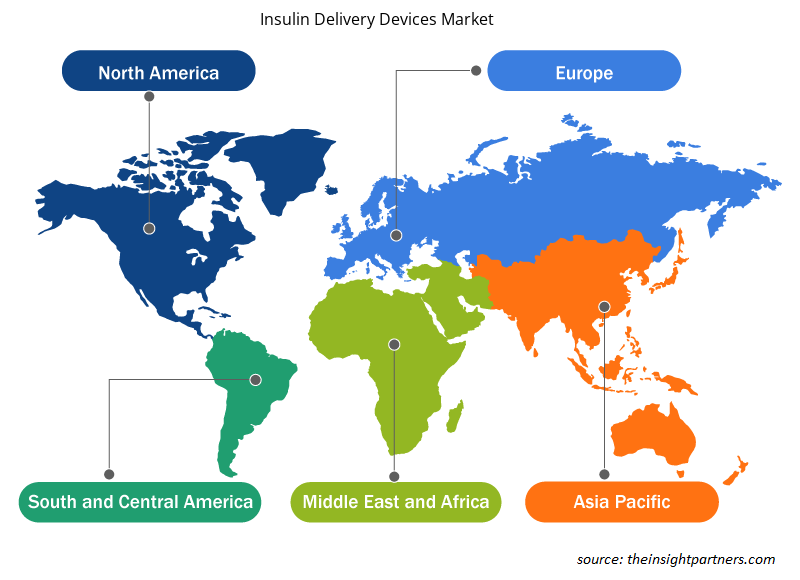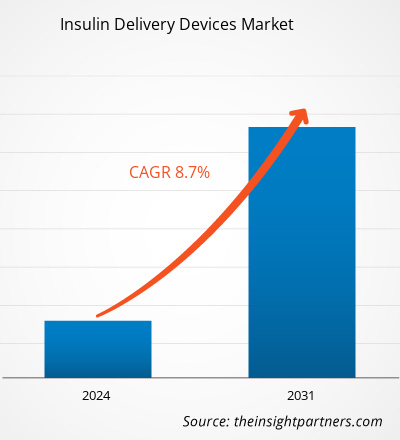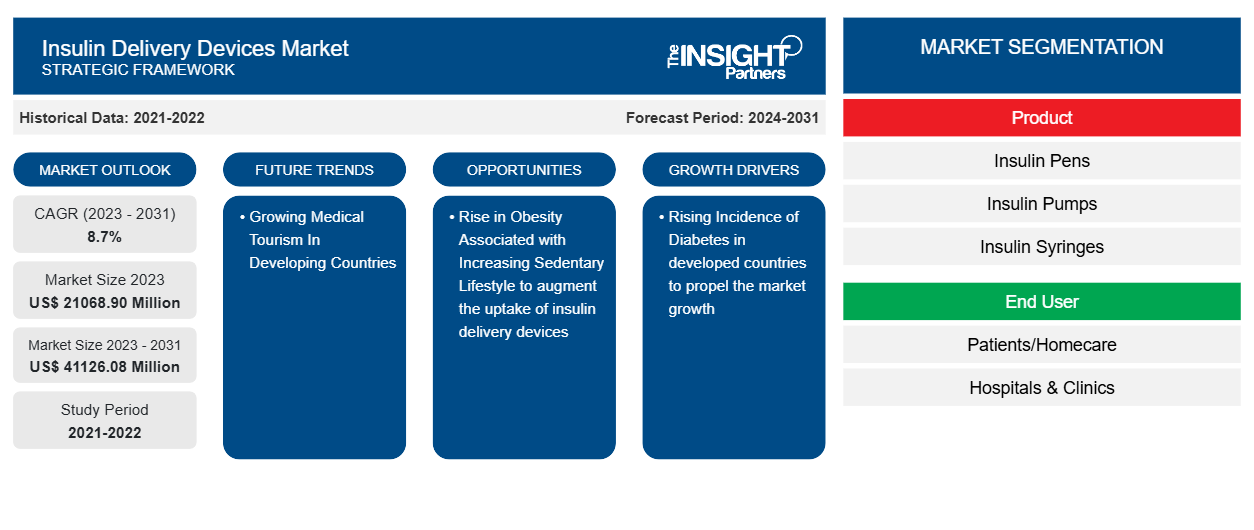Der Markt für Insulinverabreichungsgeräte soll von 21.068,90 Millionen US-Dollar im Jahr 2023 auf 41.126,08 Millionen US-Dollar im Jahr 2031 anwachsen. Der Markt soll zwischen 2023 und 2031 eine durchschnittliche jährliche Wachstumsrate von 8,7 % verzeichnen. Die zunehmenden Fortschritte bei Insulinverabreichungsgeräten werden wahrscheinlich die wichtigsten Trends auf dem Markt darstellen.
Marktanalyse für Insulinverabreichungsgeräte
Das Wachstum des Marktes wird vor allem durch die steigende Zahl von Diabetikern aufgrund von Alterung, Fettleibigkeit und ungesunder Lebensführung vorangetrieben. Spritzen und Pen-Nadeln sind die am häufigsten verwendeten Geräte zur Injektion von Insulin bei Diabetikern. Zahlreiche Hersteller entwickeln innovative Produkte, um sich in diesem stark fragmentierten Markt zu behaupten. Darüber hinaus haben die einfachen behördlichen Genehmigungen in asiatischen Ländern mittelständischen Unternehmen geholfen, in den Markt einzutreten und mit den lokalen und etablierten Marktteilnehmern zu konkurrieren.
Marktübersicht für Insulinverabreichungsgeräte
Fettleibigkeit ist eines der größten Probleme und die größte Sorge der globalen Gemeinschaft. Laut einem im Juni 2023 von Forbes veröffentlichten Bericht leiden weltweit mehr als 1 Milliarde Menschen an Fettleibigkeit – 650 Millionen Erwachsene, 340 Millionen Jugendliche und 39 Millionen Kinder. Laut der Weltgesundheitsorganisation (WHO) waren im Jahr 2020 etwa 1,9 Milliarden Erwachsene ab 18 Jahren übergewichtig. Davon waren etwa 650 Millionen Erwachsene fettleibig. Laut der im Journal of the American Heart Association vorgestellten Studie ist Fettleibigkeit jedes Jahr mit 30–53 % der neuen Diabetesfälle in den USA verbunden. Ungesunde Ernährung, Bewegungsmangel und ein schnelles Wachstum der fettleibigen Bevölkerung werden voraussichtlich die Anfälligkeit der Menschen für Diabetes weltweit erhöhen. Dies wird voraussichtlich die Nachfrage nach Insulinverabreichungsgeräten in den kommenden Jahren erhöhen. Faktoren wie die steigende Zahl geriatrischer Menschen, günstige Erstattungsrichtlinien und der zunehmende Bedarf an schnellerer und sichererer Diagnose und Behandlung von Diabetes stimulieren das Wachstum des Marktes.
Passen Sie diesen Bericht Ihren Anforderungen an
Sie erhalten kostenlos individuelle Anpassungen an jedem Bericht, einschließlich Teilen dieses Berichts oder einer Analyse auf Länderebene, eines Excel-Datenpakets sowie tolle Angebote und Rabatte für Start-ups und Universitäten.
-
Holen Sie sich die wichtigsten Markttrends aus diesem Bericht.Dieses KOSTENLOSE Beispiel umfasst eine Datenanalyse von Markttrends bis hin zu Schätzungen und Prognosen.
Markttreiber und Chancen für Insulinverabreichungsgeräte
Steigende Diabetes-Inzidenz fördert Marktwachstum
Diabetes ist eine lebensbedrohliche chronische Krankheit ohne spezifische Heilung. Sie wird hauptsächlich dadurch verursacht, dass der Körper nicht in der Lage ist, das Hormon Insulin zu produzieren oder effektiv zu nutzen. Diese Unfähigkeit verhindert, dass der Körper den Blutzuckerspiegel richtig reguliert. Es gibt zwei Arten von Diabetes, nämlich Diabetes Typ I (Diabetes insipidus) und Diabetes Typ II (Diabetes mellitus). In Ländern mit hohem Einkommen leiden etwa 91 % der Erwachsenen an Typ-2-Diabetes. Laut der International Diabetes Federation (IDF) werden im Jahr 2021 etwa 537 Millionen Menschen an Diabetes leiden, und bis 2045 wird die Zahl weltweit voraussichtlich auf 738 Millionen ansteigen. Patienten, die an Diabetes leiden, müssen häufig überwacht werden und müssen Insulin von außen verabreichen. Die weltweit zunehmende Verbreitung von Diabetes treibt das Wachstum des Marktes für Insulinverabreichungsgeräte voran.insipidus) and diabetes type-II (diabetes mellitus). In high-income countries, about 91% of adults have type 2 diabetes. According to the International Diabetes Federation (IDF), ~537 million people will be living with diabetes in 2021, and the number is expected to reach 738 million by 2045 worldwide. Patients suffering from diabetes require frequent monitoring and external administration of insulin. The growing prevalence of diabetes worldwide is driving the growth of the insulin delivery devices market.
Wachsender Medizintourismus in Entwicklungsländern
Die meisten Marktteilnehmer konzentrieren sich auf Schwellenländer, da die Zahl der Diabetespatienten zunimmt und Insulinpumpen in der Bevölkerung immer beliebter werden. In Indien hat die Medizinwissenschaft in den letzten Jahrzehnten rasante Fortschritte gemacht. Zahlreiche internationale Patienten besuchen Indien auf der Suche nach einer äußerst erschwinglichen medizinischen Versorgung. Gesundheitsreisende, die aus medizinischen Gründen in Entwicklungsländer reisen, sparen im Vergleich zu den USA 65–80 % der Gesundheitskosten. Aufgrund der bestehenden Wechselkurse und verschiedener anderer Faktoren ist die Diabetesbehandlung im Land im Vergleich zu anderen Ländern außergewöhnlich erschwinglich geworden. Laut dem Malaysia Healthcare Travel Council besuchten im Jahr 2022 mehr als 850.000 Reisende Malaysia aus medizinischen Gründen.
Das Wachstum des Medizintourismus in Schwellenländern dürfte den Akteuren auf dem Markt für Insulinverabreichungsgeräte im Prognosezeitraum erhebliche Wachstumschancen bieten. Im November 2022 stellte Roche auf der China International Import Expo (CIIE) zwei neue Blutzuckermessgeräte vor – das ACCU-CHEK Instant Glucometer und das ACCU-CHEK Guide Me Glucometer – sowie eine neue digitale Diabetesmanagementplattform, um Patienten professionelle und einfachere Lösungen für das Diabetesmanagement zu bieten.ACCU-CHEK Instant Glucometer and ACCU-CHEK Guide Me Glucometer—and a new digital diabetes management platform at the China International Import Expo (CIIE) to provide patients with professional and easier diabetes management solutions.
Segmentierungsanalyse des Marktberichts zu Insulinabgabegeräten
Wichtige Segmente, die zur Ableitung der Marktanalyse für Insulinverabreichungsgeräte beigetragen haben, sind Produkt und Endbenutzer.
- Basierend auf dem Produkt ist der Markt für Insulinverabreichungsgeräte in Insulinpens, Insulinpumpen, Insulinspritzen, Pen-Nadeln und andere unterteilt. Das Segment der Insulinpens hatte im Jahr 2023 den größten Marktanteil. Das Segment der Insulinpumpen wird im Prognosezeitraum voraussichtlich die höchste durchschnittliche jährliche Wachstumsrate verzeichnen.CAGR during the forecast period.
- Nach Endverbraucher ist der Markt in Patienten/häusliche Pflege sowie Krankenhäuser und Kliniken segmentiert. Das Segment Patienten/häusliche Pflege hatte 2023 einen größeren Marktanteil und wird im Prognosezeitraum voraussichtlich eine höhere durchschnittliche jährliche Wachstumsrate verzeichnen.homecare and hospitals & clinics. The patients/homecare segment held a larger share of the market in 2023 and is projected to register a higher CAGR during the forecast period.
Marktanteilsanalyse für Insulinverabreichungsgeräte nach Geografie
Der geografische Umfang des Marktberichts zu Insulinabgabegeräten ist hauptsächlich in fünf Regionen unterteilt: Nordamerika, Asien-Pazifik, Europa, Naher Osten und Afrika sowie Süd- und Mittelamerika.
Nordamerika dominiert den Markt für Insulinverabreichungsgeräte. Das Wachstum des Marktes in dieser Region ist auf die steigende Zahl von Diabetes, die weltweit zunehmende Verbreitung von Fettleibigkeit, die wachsende Zahl geriatrischer Bevölkerungsgruppen und die steigende Zahl von Produktinnovationen unter den Marktteilnehmern zurückzuführen. Marktteilnehmer bringen neue Produkte auf den Markt. Darüber hinaus dürften sich zunehmende Aufklärungsprogramme und Kampagnen zu Diabetes und technologischen Fortschritten in den kommenden Jahren positiv auf das Wachstum des Marktes für Insulinverabreichungsgeräte auswirken.
Im Jahr 2021 kündigte die kanadische Regierung Investitionen in Diabetes in Höhe von 35 Millionen US-Dollar an, davon 25 Millionen US-Dollar speziell für Diabetesforschung, -überwachung und -prävention sowie für die Entwicklung eines nationalen Rahmens für Diabetes. Dies beinhaltet eine erneute Zusage an die Juvenile Diabetes Research Foundation (JDRF) und die Canadian Institutes of Health Research (CIHR) Partnership to Defeat Diabetes durch Investitionen von bis zu 15 Millionen US-Dollar, die von der JDRF Kanada und ihren Spendern für die Typ-1-Diabetesforschung aufgestockt werden. Der asiatisch-pazifische Raum wird in den kommenden Jahren voraussichtlich das höchste CAGR-Wachstum aufweisen.recommitment to the Juvenile Diabetes Research Foundation (JDRF) and the Canadian Institutes of Health Research (CIHR) Partnership to Defeat Diabetes by investing up to US$ 15 million to be matched by the JDRF Canada and its donors for type 1 diabetes research. Asia Pacific is anticipated to grow with the highest CAGR in the coming years.
Regionale Einblicke in den Markt für Insulinverabreichungsgeräte
Die regionalen Trends und Faktoren, die den Markt für Insulinverabreichungsgeräte während des Prognosezeitraums beeinflussen, wurden von den Analysten von Insight Partners ausführlich erläutert. In diesem Abschnitt werden auch die Marktsegmente und die Geografie von Insulinverabreichungsgeräten in Nordamerika, Europa, im asiatisch-pazifischen Raum, im Nahen Osten und Afrika sowie in Süd- und Mittelamerika erörtert.

- Erhalten Sie regionale Daten zum Markt für Insulinverabreichungsgeräte
Umfang des Marktberichts zu Insulinabgabegeräten
| Berichtsattribut | Details |
|---|---|
| Marktgröße im Jahr 2023 | 21068,90 Millionen US-Dollar |
| Marktgröße bis 2031 | 41126,08 Millionen US-Dollar |
| Globale CAGR (2023 - 2031) | 8,7 % |
| Historische Daten | 2021-2022 |
| Prognosezeitraum | 2024–2031 |
| Abgedeckte Segmente |
Nach Produkt
|
| Abgedeckte Regionen und Länder |
Nordamerika
|
| Marktführer und wichtige Unternehmensprofile |
|
Marktteilnehmerdichte für Insulinverabreichungsgeräte: Auswirkungen auf die Geschäftsdynamik verstehen
Der Markt für Insulinverabreichungsgeräte wächst rasant, angetrieben durch die steigende Endverbrauchernachfrage aufgrund von Faktoren wie sich entwickelnden Verbraucherpräferenzen, technologischen Fortschritten und einem größeren Bewusstsein für die Vorteile des Produkts. Mit steigender Nachfrage erweitern Unternehmen ihr Angebot, entwickeln Innovationen, um die Bedürfnisse der Verbraucher zu erfüllen, und nutzen neue Trends, was das Marktwachstum weiter ankurbelt.
Die Marktteilnehmerdichte bezieht sich auf die Verteilung der Firmen oder Unternehmen, die in einem bestimmten Markt oder einer bestimmten Branche tätig sind. Sie gibt an, wie viele Wettbewerber (Marktteilnehmer) in einem bestimmten Marktraum im Verhältnis zu seiner Größe oder seinem gesamten Marktwert präsent sind.
Die wichtigsten auf dem Markt für Insulinverabreichungsgeräte tätigen Unternehmen sind:
- BD
- Novo Nordisk A/S
- B. Braun Melsungen AG
- Insulet Corporation
- Medtronic
- Tandem Diabetes Care, Inc.
Haftungsausschluss : Die oben aufgeführten Unternehmen sind nicht in einer bestimmten Reihenfolge aufgeführt.

- Überblick über die wichtigsten Akteure auf dem Markt für Insulinverabreichungsgeräte
Marktnachrichten und aktuelle Entwicklungen zu Insulinverabreichungsgeräten
Der Markt für Insulinverabreichungsgeräte wird durch die Erhebung qualitativer und quantitativer Daten nach Primär- und Sekundärforschung bewertet, die wichtige Unternehmensveröffentlichungen, Verbandsdaten und Datenbanken umfasst. Nachfolgend sind einige der Entwicklungen auf dem Markt für Insulinverabreichungsgeräte aufgeführt:
- Novo Nordisk hat zwei intelligente Insulinpens vorgestellt, NovoPen 6 und NovoPen Echo Plus, die auf Rezept für Diabetiker erhältlich sind, die in Großbritannien mit Novo Nordisk-Insulin behandelt werden. NovoPen 6 und NovoPen Echo Plus sind Insulin-Injektionspens, die Dosierungsinformationen aufzeichnen, einschließlich wann und wie viel Insulin verabreicht wurde. (Quelle: Novo Nordisk, Pressemitteilung, März 2022)
- Eli Lilly and Company hat sein Insulin-Glargin-Biosimilar Rezvoglar (Insulin-Glargin-Agar) auf dem US-Markt eingeführt. Damit ist es das zweite austauschbare Insulin-Biosimilar, das für amerikanische Diabetespatienten kommerziell erhältlich ist. (Quelle: Eli Lilly and Company, Pressemitteilung, April 2023)
Marktbericht zu Insulinverabreichungsgeräten – Umfang und Ergebnisse
Der Bericht „Marktgröße und Prognose für Insulinabgabegeräte (2021–2031)“ bietet eine detaillierte Analyse des Marktes, die die folgenden Bereiche abdeckt:
- Marktgröße und Prognose für Insulinabgabegeräte auf globaler, regionaler und Länderebene für alle wichtigen Marktsegmente, die im Rahmen des Berichts abgedeckt sind
- Markttrends für Insulinverabreichungsgeräte sowie Marktdynamik wie Treiber, Einschränkungen und wichtige Chancen
- Detaillierte PEST- und SWOT-Analyse
- Marktanalyse für Insulinverabreichungsgeräte, die wichtige Markttrends, globale und regionale Rahmenbedingungen, wichtige Akteure, Vorschriften und aktuelle Marktentwicklungen umfasst
- Branchenlandschaft und Wettbewerbsanalyse, die die Marktkonzentration, Heatmap-Analyse, prominente Akteure und aktuelle Entwicklungen auf dem Markt für Insulinverabreichungsgeräte umfasst
- Detaillierte Firmenprofile
- Historische Analyse (2 Jahre), Basisjahr, Prognose (7 Jahre) mit CAGR
- PEST- und SWOT-Analyse
- Marktgröße Wert/Volumen – Global, Regional, Land
- Branchen- und Wettbewerbslandschaft
- Excel-Datensatz
Aktuelle Berichte
Erfahrungsberichte
Grund zum Kauf
- Fundierte Entscheidungsfindung
- Marktdynamik verstehen
- Wettbewerbsanalyse
- Kundeneinblicke
- Marktprognosen
- Risikominimierung
- Strategische Planung
- Investitionsbegründung
- Identifizierung neuer Märkte
- Verbesserung von Marketingstrategien
- Steigerung der Betriebseffizienz
- Anpassung an regulatorische Trends























 Kostenlose Probe anfordern für - Markt für Insulinabgabegeräte
Kostenlose Probe anfordern für - Markt für Insulinabgabegeräte